The motto “You Wait for Nothing” is serious business for members of the Child Nutrition Services (CNS) team at Hortons Creek Elementary School in Wake County.
“The children and staff only have a certain amount of time – 30 minutes – to get their food, enjoy their meal and return to their classrooms,” said Phyllis Lewis, who works as a cashier and cook. “We don’t want them to have to wait for anything, so we have a smooth system in place to ensure meals are prepared and served on time each and every day.”
Phyllis is one of three employees who staff the cafeteria at Hortons Creek Elementary, helping to feed close to 300 students every day. Usually there are four employees but they are currently in need of an assistant manager. Food service workers like her play a vital role in the school community ensuring students receive nutritious meals. They are to be commended and celebrated this coming Wednesday on Education Support Professionals Day, as part of American Education Week.
A CNS employee for 10 years, Phyllis said it’s a job she enjoys. “I love the fellowship, the interaction with the children, seeing the smiles on their faces and being of service to them.”
The job of food service worker isn’t easy as there are a lot of moving parts involved in order to provide breakfast and lunch to students on a daily basis. Here is how a typical day for Phyllis usually pans out:
-
She arrives at 8 a.m., clocks in and checks in with her manager
-
Supplies needed for the day are prepared and temperature checks are completed for water needed to wash, rinse and sanitize dishes
-
Temperatures of the refrigerators for milk and cold foods are checked and recorded
-
Clean pans and trays needed for breakfast are stacked and eating trays for students are placed next to the serving line
-
Money for the register is counted and recorded by Phyllis and her manager, and she logs into the cash register and prepares for breakfast, which begins at approximately 8:45 a.m. and ends around 9:10 a.m.
-
After breakfast, she logs out of the computer system, counts and records the money with her manager again, and at approximately 9:30 a.m. prepares to cook lunch items.
-
Following the menu for the day, Phyllis pulls everything she needs for the day’s lunch from the freezer, which is prepped the day before. “Our menu is like the Bible,” she laughed.
-
Once food has been placed in the designated cooking device (oven steamer, etc.), she moves to other tasks associated with lunch. When the food is done, a temperature check is completed, which is very important, and it is placed in warmers. “Food safety is a top priority,” she said.
-
Lunch begins at 10:45 a.m. Minutes before the first class files into the cafeteria (by grade level, preK-5), the food is transferred to the line for serving. Then it’s showtime!
“It’s a joy to see the students every day and greet them. I’ll call their names and they’ll say, ‘How do you know my name?’ I laugh because I don’t want to tell them my secret – their names show up on the computer. Each child that comes through that line is important to me and I always address them in a positive way by complimenting them on a nice outfit or whatever the case may be. You never know the impact you’re having on a child. For them to say, ‘Miss Phyllis, you made my day’ or ‘Miss Phyllis, thank you’ is such a joy.”
After all the students are fed, cleanup begins. Dishes are washed, floors swept and mopped, trash removed, tables wiped down, and preparation begins for the next day. The process can get tedious, especially with the shortage of staff, but Phyllis said everyone works to ensure the process flows smoothly. When the clock strikes 3 p.m., the day ends.
“These children are the best part of my day."
"It’s an honor to serve them and I am thankful I get to be a role model for them as well. The opportunity to be a part of their lives is what I am most proud of as an Education Support Professional. Children are a blessing and every child, I mean every child, is important to me. Having an impact on their lives, whether in the cafeteria, in the hallways or out in the community, gives me a chance to show them where my heart is. They know I care for them, love them and want them to succeed!”
-
Phyllis has been a state employee for 25 years, but only became a member of NCAE in March of 2023.
-
She first thought NCAE was only for teachers, but when NCAE Organizer Brendan Rogers and a coworker visited her school to share the work of the Association and how being a member could help improve her working conditions, she said yes without hesitation. “I’m understanding through this organization the importance of power. Not that I didn’t know it before, but how to put power into action. That’s why I am trying to recruit others to become a part of it.”
